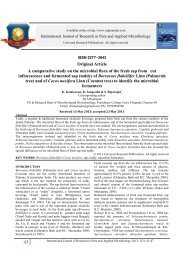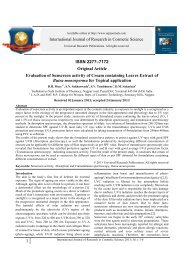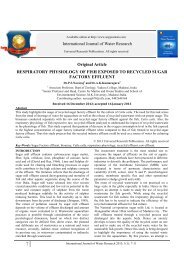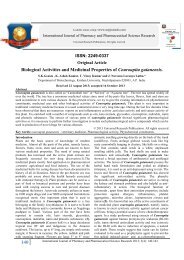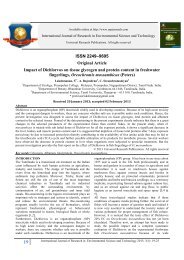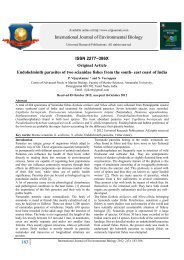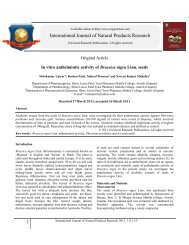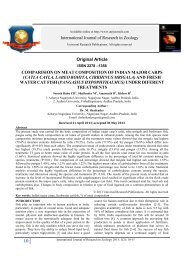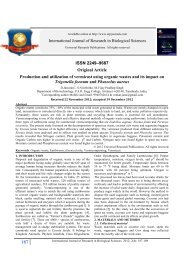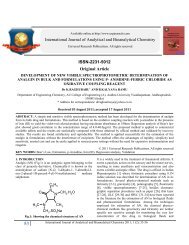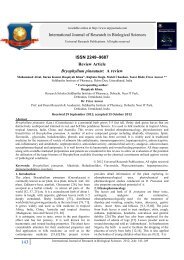Taxonomy, Reproductive Biology and Medicinal uses - URP Journals
Taxonomy, Reproductive Biology and Medicinal uses - URP Journals
Taxonomy, Reproductive Biology and Medicinal uses - URP Journals
You also want an ePaper? Increase the reach of your titles
YUMPU automatically turns print PDFs into web optimized ePapers that Google loves.
Available online at http://www.urpjournals.com<br />
International Journal of Research in Biological Sciences<br />
Universal Research Publications. All rights reserved<br />
ISSN 2249–9687<br />
Review Article<br />
Betula L. A wonder plant: <strong>Taxonomy</strong>, <strong>Reproductive</strong> <strong>Biology</strong> <strong>and</strong> <strong>Medicinal</strong> <strong>uses</strong><br />
Mohammad Saleem Wani 1 , A. H. Munshi 1 , R.C Gupta 2 <strong>and</strong> Ashiq Hussain Lone 1<br />
1<br />
Department of Botany, University of Kashmir Hazratbal Srinagar 190006 India.<br />
2<br />
Department of Botany Punjabi University Patiala 147002 India.<br />
Growth habit <strong>and</strong> occurrence: The genus Betula,<br />
commonly known as birch, belongs to the family<br />
Betulaceae .It is represented by 40 to 50 species of<br />
deciduous trees <strong>and</strong> shrubs occurring in the cooler parts of<br />
the Northern Hemisphere (Weaver 1978). It attains a height<br />
of 15-20 meters from the ground. Their bark is smooth,<br />
shining, reddish white or white, with white horizontal<br />
lenticels. The outer bark consists of numerous thin papery<br />
layers, exfoliating in broad horizontal rolls. The inner<br />
cortex is red <strong>and</strong> moist. They are fast growing <strong>and</strong> many<br />
are short lived. White barked species are weak-woody <strong>and</strong><br />
their twiggy crowns collect <strong>and</strong> hold ice <strong>and</strong> snow.<br />
Therefore they are subject to damage from winter<br />
stroms.Because of these characteristics few birches are<br />
recommended as street trees. For home gardening they are<br />
most useful when grown in association with other trees,<br />
although a few are most effective when planted as<br />
specimens. Care should be taken to prevent the outer bark<br />
of the white-barked species from being stripped or marred<br />
since the injured area will always remain green (Hyl<strong>and</strong>er,<br />
N 1957).Their leaves are ovate-acuminate, elliptic <strong>and</strong><br />
irregularly serrate.<br />
<strong>Taxonomy</strong>: The taxonomy of Betula is controversial, <strong>and</strong><br />
various classifications have been proposed. The first<br />
monographer who provided an extensive review of the<br />
genus was Regel (1865), who divided the genus into<br />
subgenera Betulaster <strong>and</strong> Eubetula. Subgenus Betulaster<br />
contains only one section, the Acuminatae. Subgenus<br />
Eubetula comprises six sections, namely Costatae, Lentae,<br />
Nanae, Albae, Fruticosae, <strong>and</strong> Dahuricae. Winkler (1904)<br />
proposed a slightly different division, lowering the status of<br />
the sections to that of subsections, merging the Fruticosae<br />
<strong>and</strong> the Dahuricae with the subsection Albae <strong>and</strong> merging<br />
the Lentae with the Costatae. More recently, De Jong<br />
(1993) proposed a division into five subgenera, namely<br />
Betulenta, Betulaster, Neurobetula, Betula <strong>and</strong><br />
Chamaebetula. Subgenus Betulenta is considered the most<br />
primitive subgenus, followed by Betulaster <strong>and</strong><br />
Neurobetula. Neurobetula is considered a very<br />
heterogeneous <strong>and</strong> partly artificial group (De Jong 1993).<br />
Received 23 March 2013; accepted 24 April 2013<br />
The subgenera Chamaebetula <strong>and</strong> Betula are considered to<br />
be more derived. Hybridization <strong>and</strong> introgression are<br />
common in Birches where the natural distributions of birch<br />
species overlap, for example among the European birch<br />
species B. pendula, B. pubescens, <strong>and</strong> B. nana (Palme et al.<br />
2004). Betula utilis D.Don the only critically endangered<br />
species has been reported from North-West Himalaya <strong>and</strong><br />
Kashmir but Steward (1982) has collected number of<br />
accession mostly described them either as sub-species<br />
/varieties due to which the taxonomy of the species is<br />
doubtful <strong>and</strong> need further scientific investigation for their<br />
correct taxonomic structure. Moreover, several of the<br />
recognized Betula species have a hybrid origin (Nagamitsu<br />
et al. 2006). Hybrids generally show morphology<br />
intermediate between the parental species but are not<br />
always morphologically distinct as a group (Thórsson et al.<br />
2001). This overlap in morphological features complicates<br />
species <strong>and</strong> hybrid identification. Introgression appears to<br />
be bidirectional (Williams <strong>and</strong> Arnold 2001) but<br />
asymmetrical (Palme et al. 2004). Hybridization <strong>and</strong><br />
introgression are further facilitated by the introduction <strong>and</strong><br />
distribution of artificially propagated cultivars outside the<br />
natural distribution range. The simultaneous occurrence of<br />
polyploidization, extensive hybridization, <strong>and</strong> introgression<br />
complicates taxonomical studies in the genus Betula.<br />
Flowering <strong>and</strong> fruiting: Mature birch trees carry large<br />
amounts of female <strong>and</strong> male catkins <strong>and</strong> the flowers are<br />
monoecious bloom in May June (Koski <strong>and</strong> Tallqvist,<br />
1978). Staminate catkins are formed in late summer or<br />
autumn, remain naked during winter, <strong>and</strong> open after<br />
considerable elongation in the spring. The pistillate catkins,<br />
which are cone-like with closely overlapping scales are<br />
born terminally on short, spur-like lateral branches <strong>and</strong><br />
appear with the leaves .When the female catkins (strobilus)<br />
ripen in late summer or autumn, they become brown <strong>and</strong><br />
woody <strong>and</strong> are either erect or pendulous. Each scale may<br />
bear a single small, winged nut (seed) that is oval, with two<br />
persistent stigmas at the apex. The seeds turn from greenish<br />
tan to light brown or tan when mature (Brinkman 1974).<br />
Seeds disperse from late fall until the following spring<br />
94<br />
International Journal of Research in Biological Sciences 2013; 3(2): 93-97
(Houle <strong>and</strong> Payette 1990; Matlack 1989) <strong>and</strong> are thin <strong>and</strong><br />
winged. Although seeds can begin to disperse in late<br />
summer, these early-shed seeds may be of poor quality.<br />
Wind play important role <strong>and</strong> blow seeds along the surface<br />
of the snow up to 80 m from the mother tree. Ford et al<br />
(1983) trapped about 5% of the total seed-fall from roundleaf<br />
birch at nearly 100 m from the parent tree. An<br />
abundance of seeds can be found in the forest soil, but these<br />
seeds are found to be short-lived. Most seeds are nonviable<br />
after the second or third year (Granstrom 1987; Granstrom<br />
<strong>and</strong> Fries 1985; Johnson 1975; Moore <strong>and</strong> Wein 1977;<br />
Perala <strong>and</strong> Alm 1989; Steijlen <strong>and</strong> Zackrisson 1986). The<br />
abundance of seeds in the forest soil is, therefore, likely<br />
supported by regular replenishment from new crops<br />
(Komarova 1986). A rare case of excessive seed production<br />
has been observed to lead to crown deterioration <strong>and</strong><br />
reduced growth of the parent trees (Gross 1972). Seeds of<br />
yellow birch shed in August were found non-viable. Viable<br />
seeds were not released in meaningful amounts until<br />
September, with the maximum of good seeds being<br />
released in October (Houle <strong>and</strong> Payette 1990). After seed<br />
fall, the strobilus slowly disintegrates on the trees, with the<br />
axes persisting on the branch lets.<br />
Seed production, collection <strong>and</strong> extraction: Lepisto<br />
(1973) reported Birches tends to flower at the relatively<br />
young age of 10 to 15 years .Some individuals are<br />
precocious in flowering <strong>and</strong> this appears to be under<br />
genetic control (Huhtinen <strong>and</strong> Yahyaoglu 1974). In<br />
greenhouse conditions with irrigation, fertilizers <strong>and</strong> CO 2 -<br />
enriched air, European white birch seedlings have produced<br />
male catkins as early as 9 months <strong>and</strong> commercial<br />
quantities of seed from 5-year-old trees (Lepisto 1973).<br />
Bjorkbom <strong>and</strong> others (1965) reported that paper birch<br />
produced a higher proportion of viable seeds in good seed<br />
years than it did during poor seed years. The percentage of<br />
viable birch seeds can be estimated by examining the seeds<br />
on a light table (Patterson <strong>and</strong> Bruce 1931).The number of<br />
seeds per square meter in a birch st<strong>and</strong> can be hundreds of<br />
thous<strong>and</strong>s (Koski <strong>and</strong> Tallqvist, 1978). When birch<br />
seedlings are raised in continuous light together with high<br />
nutrient level <strong>and</strong> elevated CO 2 concentration in a<br />
greenhouse, the generation time from seed to seed can be<br />
reduced to less than 1 year (Kärki, 1976). Commercial seed<br />
production starts 2 years after establishment in a less<br />
intensive polythene seed orchard. Birch flowering starts<br />
early in the spring after a certain threshold temperature is<br />
reached. Due to the elevated temperature in the poly house,<br />
the flowering time is some weeks earlier than outside,<br />
which totally eliminates the risk of pollen contamination.<br />
The ability of birch to „accelerate breeding‟, making it is<br />
possible to get any seedling or graft to flower <strong>and</strong> set seed<br />
within a few years, is a crucial advantage relative to<br />
conifers.<br />
Birch seeds are collected by picking or stripping the<br />
strobilus from st<strong>and</strong>ing trees or shrubs or from trees. This is<br />
done best when the strobiles are still green enough to hold<br />
together. Because ripe strobilus shatters readily, they are<br />
put directly into bags rather than allowed to fall onto the<br />
ground or tarps, which can result in loss of seed.<br />
Freshly collected strobilus can be subject to heating as they<br />
are usually green. They should be spread out to dry for<br />
several weeks until they begin to disintegrate. Low relative<br />
humidity is the most important way in drying the strobiles.<br />
Once the strobilus begin to fall apart, they can be shattered<br />
by rubbing or shaking or can be put in the blender, <strong>and</strong> the<br />
seeds can be separated from most of the scales <strong>and</strong> debris<br />
by screening <strong>and</strong> fanning. Round-hole screens of the<br />
following sizes have proved satisfactory for the following<br />
species: gl<strong>and</strong>ulose birch, 2.38 mm; yellow birch, 3.2 mm;<br />
river birch, 4 mm; paper birch, 3.2 mm; European white<br />
<strong>and</strong> downy birches, 2.6 mm. The remaining scales can be<br />
removed by fanning (Brinkman 1974). Birch seeds are very<br />
small <strong>and</strong> light <strong>and</strong> show considerable variation with the<br />
number per weight <strong>and</strong> yield per volume among species.<br />
Seed Germination: European white birch (Black <strong>and</strong><br />
Wareing 1955, Vaartaja 1956) <strong>and</strong> paper birch (Bevinton<br />
<strong>and</strong> Hoyle 1981) can germinate in the dark, whereas<br />
monarch <strong>and</strong> Japanese white birches <strong>and</strong> Erman birch<br />
require light (Nagata <strong>and</strong> Black 1977; Nagata <strong>and</strong> Tsuda<br />
1975; Odani <strong>and</strong> Anma 1986). Giberellic acid (GA3) in<br />
concentrations of 50 to 100 ppm could substitute for the<br />
light with Erman birch (Odani <strong>and</strong> Anma 1986).<br />
The basic chromosome number of Betula is n=14, <strong>and</strong> the<br />
species form a series of polyploids with chromosome<br />
numbers of 2n=28, 56, 70, 84, 112, <strong>and</strong> 140 (Furlow 1990).<br />
Some robust <strong>and</strong> fast-growing silver birch individuals have<br />
been found to be triploid (2 n = 42) (Sarvas, 1958).<br />
Polyploidy is a common feature among Betula species, <strong>and</strong><br />
its presence within at least four of the five recognized<br />
subgenera suggests several independent polyploidization<br />
events.<br />
<strong>Medicinal</strong> Use: Betulin, lupeol, oleanolic acid, acetylo-<br />
-heanolic acid, betulitc acid, lupenone, sitosterol, methyl<br />
betulonate, <strong>and</strong> methyl betulate have been extracted from<br />
its bark. A new triterpenoid, called karachic rustics which<br />
is aromatic <strong>and</strong> has antiseptic properties (Barnes et al 1974;<br />
Bevington et al, 1981) have also been extracted. The<br />
compound Betulin shows anticancer activity by suppressing<br />
growth of malignant melanoma <strong>and</strong> cancer of liver <strong>and</strong><br />
lungs (Kikuzaki, H <strong>and</strong> Nakatani, 1993). According to<br />
literature Betulin is a pentacyclic triterpene with the lupane<br />
skeleton whose existences in nature have been reported<br />
since 1788, isolated from birch bark as pure chemical<br />
substance by sublimation <strong>and</strong> elemental analysis of this<br />
natural constitutes was done in 1876 (Hayak et. al., 1989).<br />
Traditionally birch bark has been used as rheumatism, gout,<br />
malaria (Hager 1967) by human being. Betulin can be<br />
isolated (Ender et. al. 2003) from the outer layer of the bark<br />
of Betula alba with maximum yield. It can also be isolated<br />
from the Himalayan birch tree, Betula utilis that contains<br />
betulin up to 12% of its weight. Betulin is an ideal starting<br />
material for the synthesis of biologically active betulinic<br />
acid via jone‟s oxidation method. Betulin <strong>and</strong> its<br />
derivatives possess biological effects, e.g. Antiinflammatory,<br />
antiviral, anti-HIV, hepato protective.<br />
(Dzubak et. al. 2006). Some of derivatives of betulinic acid<br />
also show high anti-HIV <strong>and</strong> antiviral activities (Dzubak et.<br />
al. 2006). Betulinic acid has been studied more extensively<br />
then betulin, having selective antitumor activity against<br />
human melanoma cell culture <strong>and</strong> anti- HIV activity.<br />
95<br />
International Journal of Research in Biological Sciences 2013; 3(2): 93-97
Several species produces valuable lumber. In Northern<br />
Europe, pollen of birch is a major cause of hay fever<br />
complaints, as is pollen of the Fagales species hazel <strong>and</strong><br />
alder (Breiteneder et al. 1989, 1992; Lüttkopf et al. 2002).<br />
The major allergen involved is Betv 1 of which several<br />
variants exist that may differ in their allergenicity (Ferreira<br />
et al. 1996, 1997; Schenk et al. 2006).<br />
The bronze birch borer, Agrilus anxius Gory, is<br />
the major lethal pest of white-barked birches. The larvae of<br />
this native buprestid beetle form extensive mines in the<br />
cambial-phloem region beneath the bark, leading to the<br />
death of large branches <strong>and</strong> entire trees. Fisher (1928) listed<br />
B. papyrifera, B. alba L. (which includes both B. pendula<br />
<strong>and</strong> B. pubescens), B. populifolia, B. lenta, <strong>and</strong> B. lutea (=<br />
B. alleghaniensis) as hosts of bronze birch borer. Weaver<br />
(1978) based his observations on trees growing at the<br />
Arnold Arboretum in Massachusetts <strong>and</strong> rated B. pendula,<br />
B. populifolia, <strong>and</strong> B. albosinensis as susceptible, with B.<br />
papyrifera being slightly less susceptible. Weaver listed B.<br />
davurica, B. ermanii, <strong>and</strong> B. maximowicziana (monarch<br />
birch) as probably resistant species.<br />
AKNOWLEDGEMENT:<br />
The concept of the article has been conceived while<br />
working on “ALL INDIA COORDINATED PROJECT ON<br />
REPRODUCTIVE BIOLOGY OF RARE, ENDANGERED<br />
AND THREATENED (RET) TREE” (Betula utilis D. Don)<br />
sponsored by Ministry of Environment <strong>and</strong> Forest<br />
Government of India New Delhi.<br />
REFERENCES<br />
1. Ahlgren CE., 1957. Phenological observations of nineteen<br />
native tree species. Ecology, 38(4): 622B628.<br />
2. Andersen, P. C., P.B. Lombard, <strong>and</strong> M.N. Westwood.,<br />
1984. Leaf conductance, growth, <strong>and</strong> survival of willow<br />
<strong>and</strong> deciduous fruit tree species under flooded soil<br />
conditions. J. Amer. Soc. Hort. Sci, 109: 132–138.<br />
3. Barnes BV, Danick BP, Sharik TL. 1974. Natural<br />
hybridization of yellow birch <strong>and</strong> birch. Forest Science,<br />
20: 215B221.<br />
4. Bevington JM, Hoyle MC. 1981. Phytochrome action<br />
during prechilling induced germination of Betula<br />
papyrifera Marsh. Plant Physiology, 67: 705B710.<br />
5. Bjorkbom JC, Marquis DA, Cunningham FE., 1965. The<br />
variability of paper birch seed Production, dispersal, <strong>and</strong><br />
germination. Res. Pap. NE-41. Upper Darby, PA: USDA<br />
Forest Service, Northeastern Forest Experiment Station. 8<br />
p.<br />
6. Black M, Wareing P F., 1955. Growth studies in woody<br />
species: 8. Photoperiodic control of germination in<br />
Betula pubescens Ehrh. Physiologia Plantarum, 8(2):<br />
300B316.<br />
7. Breiteneder H, Ferreira F, Reikerstorfer A, Duchene M,<br />
Valenta R, Hoffmann-Sommergruber K, Ebner C,<br />
Breitenbach M, Kraft D, Scheiner O., (1992)<br />
Complementary DNA cloning <strong>and</strong> expression in<br />
Escherichia coli of Aln g I, the major allergen in pollen of<br />
Alder (Alnus glutinosa). J Allergy Clin Immunol, 90:909–<br />
917.<br />
8. Breiteneder H, Pettenburger K, Bito A, Valenta R, Kraft<br />
D, Rumpold H, Scheiner O, Breitenbach M., (1989) The<br />
gene coding for the major birch pollen allergen Bet v I, is<br />
highly homologous to a pea disease resistance response<br />
gene. EMBO J 8:1935–1938.<br />
9. Brinkman KA., 1974. Betula, birch. In: Schopmeyer CS,<br />
tech coord. Seeds of woody plants of the United States.<br />
Agric. H<strong>and</strong>bk. 450. Washington, DC: USDA Forest<br />
Service: 316B320.<br />
10. De Jong PC. , (1993) An introduction to Betula: Its<br />
morphology, evolution, classification <strong>and</strong> distribution<br />
with a survey of recent work. The IDS Betula<br />
Symposium, International Dendrology Society, Susses,<br />
U.K.<br />
11. Dzubak P, Hajduch M, Vydra D, Hustova A, Kvasnica M,<br />
Biedermann D, Markova L, Urban M, Sarek J.,<br />
Pharmacological activities of natural triterpenoids <strong>and</strong><br />
their therapeutic implications, Nat. Prod. Rep. 2006, 23,<br />
394.<br />
12. Ender, C.; Sauter, M., DE 10204278 C1, 2003; Chem.<br />
Abstr. 607453.<br />
13. Ferreira F, HirthenlehnerK, Briza P, Breiteneder H,<br />
Scheiner O, Kraft D, Breitenbach M, Ebner C., (1997)<br />
Isoforms of atopic allergens with reduced allergenicity<br />
but conserved T cell antigenicity: possible use for specific<br />
immunotherapy. Int Arch Allergy Immunol, 113:125–127<br />
14. Ferreira F, HirtenlehnerK, Jilek A, Godnik-Cvar J,<br />
BreitenederH, Grimm R, Hoffmann- Sommergruber K,<br />
Scheiner O, Kraft D, Breitenbach M, Rheinberger H-J,<br />
Ebner C., (1996) Dissection of immunoglobulin E <strong>and</strong> T<br />
lymphocyte reactivity of isoforms of the major birch<br />
pollen allergen Bet v 1: potential use of hypoallergenic<br />
isoforms for immunotherapy. J Exp Med, 183:599–609.<br />
15. Fisher, W.S., 1928. A revision of the North American<br />
species of buprestid beetles belonging to the genus<br />
Agrilus. U.S. Nat. Mus. Bull, 145. 347 pp.<br />
16. Ford RH, Sharik TL, Feret PP., 1983. Seed dispersal of<br />
the endangered Virginia round-leaf birch (Betula uber).<br />
Forest Ecology <strong>and</strong> Management, 6: 115B128.<br />
17. Furlow JJ (1990) The genera of Betulaceae in the<br />
southeastern United States. J Arnold Arbor, 71:1–67.<br />
18. Granstrom A, Fries C., 1985. Depletion of viable seeds of<br />
Betula pubescens <strong>and</strong> Betula verrucosa sown onto some<br />
north onto some north Swedish forest soils. Canadian<br />
Journal of Forest Research, 15: 1176B1180.<br />
19. Granstrom A., 1987. Seed viability of fourteen species<br />
during five years of storage in a forest soil. Journal of<br />
Ecology, 75: 321B331.<br />
20. Gross HL. 1972. Crown deterioration <strong>and</strong> reduced growth<br />
associated with excessive seed production by birch.<br />
Canadian Journal of Botany, 50: 2431B2437.<br />
21. Hager H, List PH, <strong>and</strong> Hiirhammer L., H<strong>and</strong>buch der<br />
Pharmazeutischen Praxis, 1967-1980, 4th Edn, Springer,<br />
Berlin.<br />
22. Hasselkus, E., 1984. Introducing Betula platyphylla<br />
„Whitespire‟. Arnoldia, 44:36-38.<br />
23. Hayek EWH, Jordis U, Moche W <strong>and</strong> Sauter F., A<br />
Bicentennial of Betulin. Photochemistry, 1989, 28 (9),<br />
2229-2242.<br />
24. Houle G, Payette S. 1990., Seed dynamics of Betula<br />
alleghaniensis in a deciduous forest of northeastern North<br />
America. Journal of Ecology, 78: 677B690.<br />
25. Huhtinen O, Yahyaoglu Z., 1974. Das frühe Blühen von<br />
aus Kalluskulturen herangezogenen Pflänzchen bei der<br />
Birke (Betula pendula Roth.). Silvae Genetica, 23(1/3):<br />
32B34.<br />
26. Hyl<strong>and</strong>er, N., 1957.On cut-leaved <strong>and</strong> small-leaved<br />
forms of Sc<strong>and</strong>inavian birches.Svensk Botanist Tidskrift,<br />
96<br />
International Journal of Research in Biological Sciences 2013; 3(2): 93-97
51:417-436.<br />
27. Johnson EA., 1975. Buried seed populations in the<br />
subarctic forest east of Great Slave Lake, Northwest<br />
Territories. Canadian Journal of Botany, 53:<br />
2933B2941.<br />
28. Kärki, L., 1976 Toward more effective tree breeding<br />
through the use of flower induction halls. Yearbook 1976.<br />
The Foundation for Forest Tree Breeding, pp. 37 – 45.<br />
29. Kikuzaki, H. <strong>and</strong> N. Nakatani, 1993.Antioxidant effects<br />
of some ginger constituents. Food Sci., 58: 1407-1410.<br />
30. Komarova TA., 1986. Role of forest fires in germination<br />
of seeds dormant in the soil. Soviet Journal of Ecology,<br />
16(6): 311-315.<br />
31. Koski, V. <strong>and</strong> Tallqvist. R., 1978 Results of long-time<br />
measurements on the quantity of fl owering <strong>and</strong> seed crop<br />
of forest trees. Folia For, 364, 1 – 60.<br />
32. Larson, K. D., B. Schaffer, <strong>and</strong> F.S. Davies., 1991.<br />
Flooding, leaf gas exchange, <strong>and</strong> growth of mango in<br />
containers. J. Amer. Soc. Hort. Sci, 116:156-160.<br />
33. Lepisto M., 1973. Accelerated birch breeding in plastic<br />
greenho<strong>uses</strong>. Forestry Chronicle, 49(4): 172- 173.<br />
34. Lüttkopf D, Müller U, Skov PS, Ballmer-Weber BK,<br />
Wüthrich B, Hansen KS, Poulsen LK, Kästner M,<br />
Haustein D, Vieths S., (2002) Comparison of four<br />
variants of a major allergen inhazelnut (Corylus avellana)<br />
Cor a 1.04 with the major hazel pollen allergen Cor a<br />
1.01. Mol Immunol, 38:515–525.<br />
35. Matlack GR., 1989. Secondary dispersal of seed across<br />
snow in Betula lenta, a gap-colonizing tree species.<br />
Journal of Ecology, 77: 853B869.<br />
36. McKim, H. L., L.W. Gratta, <strong>and</strong> C.J. Merry., 1975.<br />
Inundation damage to vegetation at selected New Engl<strong>and</strong><br />
flood control reservoirs. U.S. Army Cold Regulat. Res.<br />
<strong>and</strong> Eng. Lab., Hanover, New Hampshire.<br />
37. Moore JM, Wein RW., 1977. Viable seed populations by<br />
soil depth <strong>and</strong> potential site recolonization after<br />
disturbance. C<strong>and</strong>ian Journal of Botany, 55: 2408B2412.<br />
38. Nadakarni, K.M., 1976. Betula utilis D.Don, In: Indian<br />
Mater. Med., 1: 198-1296.<br />
39. Nagamitsu T, Kawahara T, Kanazashi A., (2006)<br />
Endemic dwarf birch Betula apoiensis (Betulaceae) is a<br />
hybrid that originated from Betula ermanii <strong>and</strong> Betula<br />
ovalifolia. Plant Species Biol, 21:19–29.<br />
40. Nagata H, Tsuda Y., 1975. Action of far-red <strong>and</strong> blue<br />
lights on the germination of Japanese white birch seed.<br />
Journal of the Japanese Forestry Society, 57(5): 160B163.<br />
41. Norby, R.J. <strong>and</strong> T.T. Kozlowski., 1983. Flooding <strong>and</strong> SO 2<br />
stress interaction in Betula papyrifera <strong>and</strong> B. nigra<br />
seedlings. For. Sci, 29:739–750.<br />
42. Odani K, Anma Y., 1986. Betula ermani seed<br />
germination regulated by gibberellin. Journal of the<br />
Japanese Forestry Society, 68(12): 511B513.<br />
43. Palme AE, Su Q, Palsson S, Lascoux M., (2004)<br />
Extensive sharing of chloroplast haplotypes among<br />
European birches indicates hybridization among Betula<br />
pendula, B. pubescens <strong>and</strong> B. nana. Mol Ecol, 13:167–<br />
178.<br />
44. Patterson C F, Bruce AC., 1931. Rapid methods of<br />
determining the percentages of fertility <strong>and</strong> sterility in<br />
seeds of the genus Betula. Science Agriculture (Ottawa),<br />
11: 704B708.<br />
45. Perala DA, Alm AA., 1989. Regenerating paper birch in<br />
the lake states with the shelterwood method. Northern<br />
Journal of Applied Forestry, 6: 151B153.<br />
46. Pereira, J.S. <strong>and</strong> T.T. Kozlowski., 1977. Variations<br />
47. among woody angiosperms in response to flooding.<br />
Physiol. Plant, 41:184-192.<br />
48. Ranney, T. G., R.E. Bir, <strong>and</strong> W.A. Skroch., 1991.<br />
Comparative drought resistance among six species of<br />
birch (Betula): Influence of mild water stress on water<br />
relations <strong>and</strong> leaf gas exchange. Tree Physiol, 8:351–360.<br />
49. Regel E., (1865) Bemerkungen über die Gattungen Betula<br />
und Alnus nebst Beschreibung einiger neuer Arten. Bull<br />
Soc Nat Moscou, 38:388–434.<br />
50. Sarvas, R., 1958 Two triploid aspens <strong>and</strong> two triploid<br />
birches. Commun. Inst. For. Fenn. 49 (7), 1 – 25 [in<br />
Finnish with English summary].<br />
51. Schenk MF, Gilissen LJWJ, Esselink GD, Smulders<br />
MJM., (2006) Seven different genes encode a diverse<br />
mixture of Isoforms of Bet v I.<br />
52. Selvam, A.B.D., 2008. Inventory of Vegetable Crude<br />
Drug samples housed in Botanical Survey of India,<br />
Howrah. Pharmacognosy Magazine, 2(3): 61-94.<br />
53. Steijlen I, Zackrisson O., 1986. Long-term regeneration<br />
dynamics <strong>and</strong> successional trends in a northern Swedish<br />
coniferous forest st<strong>and</strong>. Canadian Journal of Botany, 65:<br />
839B848.<br />
54. Sojka, R.E. <strong>and</strong> L.H. Stolzy., 1980. Soil-oxygen effects<br />
on stomatal response. Soil Sci, 130:350-358.<br />
55. Tang, Z.C. <strong>and</strong> T.T. Kozlowski., 1983. Further studies in<br />
flood tolerance of Betula papyrifera seedlings. Physiol.<br />
Plant, 59:218–222.<br />
56. Tang, Z.C. <strong>and</strong> T.T. Kozlowski., 1982. Some<br />
physiological <strong>and</strong> growth responses of Betula papyrifera<br />
seedlings to flooding. Physiol. Plant, 55:415-420.<br />
57. Thórsson ÆT, Salmela E, Anamthawat-Jónsson K.,<br />
(2001) Morphological, cytogenetic, <strong>and</strong> molecular<br />
evidence for introgressive hybridization in birch. J<br />
Heredity, 92:404–408.<br />
58. Tsukahara, H. <strong>and</strong> T.T. Kozlowski., 1986. Effect of<br />
flooding <strong>and</strong> temperature regime on growth <strong>and</strong> stomatal<br />
resistance of Betula platyphylla var. japonica seedlings.<br />
Plant& Soil, 92:103-112.<br />
59. Vaartaja O., 1956. Photoperiodic response in germination<br />
of seed of certain trees. Canadian Journal of Botany, 34:<br />
377B388.56. Nagata H, Black M., 1977. Phytochromechilling<br />
interaction in the control of seed dormancy of<br />
Betula maximowicziana Reg. Journal of the<br />
Japanese Forestry Society, 59(10): 368B371.<br />
60. Weaver, R.E., Jr., 1978. The ornamental birches.<br />
Arnoldia, 38(4):117-131.<br />
61. Williams JH, Arnold ML., (2001) Sources of genetic<br />
structure in the woody perennial Betula occidentalis. Int J<br />
Plant Sci, 162:1097– 1109.<br />
62. Winkler H., (1904) Betulaceae. Das Pflanzenreich, 19: 1–<br />
149.<br />
Source of support: Nil; Conflict of interest: None declared<br />
97<br />
International Journal of Research in Biological Sciences 2013; 3(2): 93-97



